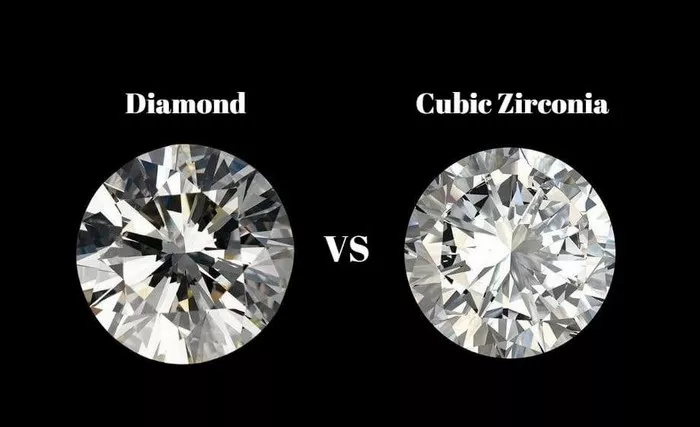In the world of gemstones, diamonds and cubic zirconia often get mistaken for one another due to their similar appearance. Both possess a brilliant sparkle and are commonly used in jewelry, but they are vastly different in composition and value. For consumers seeking authenticity and value, it’s crucial to understand how to tell these two apart. This guide aims to provide a comprehensive overview of the key differences between diamonds and cubic zirconia, equipping readers with the knowledge needed to make informed purchasing decisions.
Understanding the Basics:
Before delving into specific methods of differentiation, it’s essential to grasp the fundamental distinctions between diamonds and cubic zirconia.
Diamonds:
Diamonds are naturally occurring gemstones formed deep within the Earth’s mantle under high pressure and temperature conditions. Comprised of carbon atoms arranged in a crystalline structure, diamonds are renowned for their exceptional hardness, ranking as the hardest known natural material on Earth according to the Mohs scale.
Cubic Zirconia:
In contrast, cubic zirconia (CZ) is a synthetic gemstone created in laboratories. While it may resemble diamonds in appearance, cubic zirconia is composed of zirconium dioxide (ZrO2) crystals. CZ is synthesized through a process that mimics the conditions under which natural diamonds form, but it lacks the same geological origin and inherent properties.
Now, let’s explore the various methods for differentiating between diamonds and cubic zirconia:
Visual Inspection:
A. Brilliance and Sparkle:
Both diamonds and cubic zirconia exhibit brilliance and sparkle when exposed to light, but they do so in slightly different ways. Diamonds often display a subtle rainbow of colors known as fire due to their dispersion properties, whereas cubic zirconia may emit more vibrant and uniform flashes of color.
B. Flaws and Inclusions:
Natural diamonds frequently contain internal flaws or inclusions, which are imperfections formed during their crystallization process. These flaws can vary in size, shape, and visibility, ranging from tiny specks to noticeable blemishes. In contrast, cubic zirconia typically lacks such natural imperfections and appears flawless under magnification.
Physical Properties:
A. Hardness:
Diamonds are renowned for their exceptional hardness, scoring a perfect 10 on the Mohs scale. This hardness makes diamonds highly resistant to scratches and abrasions, allowing them to maintain their luster over time. Cubic zirconia, while still relatively durable, is softer than diamonds and may show signs of wear more quickly.
B. Density:
Diamonds have a higher density compared to cubic zirconia. This difference in density can be detected by weighing the gemstones and comparing their mass for a given volume. However, this method requires precision instruments and may not be feasible for the average consumer.
Gemological Testing:
For a conclusive determination of whether a stone is a diamond or cubic zirconia, professional gemological testing is recommended. Gemologists utilize specialized equipment and techniques to analyze various properties of gemstones, including their refractive index, thermal conductivity, and fluorescence.
A. Refractive Index:
Diamonds and cubic zirconia have different refractive indices, which affect how light travels through the gemstone and influences its brilliance. Gemological refractometers can measure the refractive index of a stone, helping to distinguish between diamonds and cubic zirconia based on this property.
B. Thermal Conductivity:
Diamonds have exceptionally high thermal conductivity compared to most other gemstones, including cubic zirconia. This property allows gemologists to use thermal conductivity testers, such as a diamond tester pen, to quickly differentiate between diamonds and cubic zirconia based on their heat dissipation rates.
C. Fluorescence:
Under ultraviolet (UV) light, some diamonds exhibit fluorescence, emitting a visible glow in various colors. While the presence of fluorescence does not necessarily indicate whether a stone is a diamond or cubic zirconia, it can provide additional information to support other testing methods.
Conclusion:
Distinguishing between diamonds and cubic zirconia requires careful examination and consideration of various factors, including visual appearance, physical properties, and gemological testing results. While cubic zirconia may offer an affordable alternative to diamonds, particularly for those on a budget, it’s essential for consumers to be able to identify and differentiate between these two gemstones accurately.
By employing the methods outlined in this guide, individuals can confidently assess whether a stone is a genuine diamond or cubic zirconia, empowering them to make informed purchasing decisions when shopping for jewelry or gemstones. Whether for personal adornment or investment purposes, understanding the differences between diamonds and cubic zirconia is key to selecting the right gemstone for any occasion.
FAQs
Are diamonds harder than cubic zirconia?
Yes, diamonds are significantly harder than cubic zirconia. Diamonds score a perfect 10 on the Mohs scale of hardness, making them the hardest known natural material. Cubic zirconia is softer, typically ranking around 8.5 on the Mohs scale.
Can I use a diamond tester to differentiate between a diamond and cubic zirconia?
Yes, a diamond tester, which measures thermal conductivity, can be used. Diamonds have a much higher thermal conductivity than cubic zirconia. If the tester indicates high thermal conductivity, the stone is likely a diamond; if not, it is likely cubic zirconia or another diamond simulant.
Does cubic zirconia have any inclusions like natural diamonds?
Typically, no. Cubic zirconia is synthesized to be flawless, lacking the natural inclusions and imperfections found in diamonds. However, this lack of inclusions can sometimes be a clue that the stone is not a natural diamond.
Can cubic zirconia scratch easily?
Compared to diamonds, cubic zirconia is more prone to scratching. Diamonds’ superior hardness makes them highly resistant to scratches, maintaining their luster over time. Cubic zirconia, being softer, can show wear and scratches more quickly.

